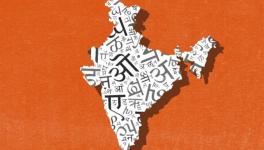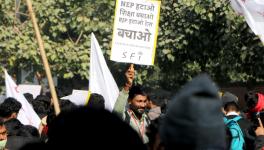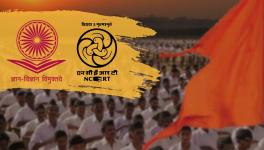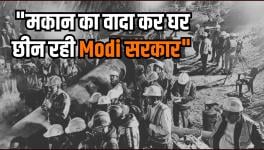Design or Hack Job? Evolution and Periodic Table Scrapped

The chapter on the periodic table was the last chapter of the chemistry part of the earlier text. Given that the material covered in earlier sections and chapters is often referred to in later chapters, for anyone doing a quick job of ‘rationalising’ the text, it made sense to delete the last chapters and sections. | Image courtesy: Pxfuel
The decision by the National Council of Education Research and Training (NCERT) to remove the theory of evolution and the periodic table from the prescribed science textbook for tenth-standard students snowballed into a major controversy. Even Nature, one of the oldest science journals of international repute, found it important enough to write an editorial.
The NCERT has justified these deletions as a “rationalisation” of the syllabus to reduce the burden of rote learning on students by removing overlapping and difficult topics. A look at the latest and previous versions of the textbook indicates the actual reasons may be very different. These deletions raise questions about science pedagogy in schools. The manner and choice of deleted topics indicate a hack job rather than a well-thought-out exercise.
The anti-science ideology of the current regime has been cited as a possible reason. However, a technocratic mindset with an elitist bias, which is increasingly the hallmark of the New Education Policy, appears to be more at work than ideological fixation.
Deletions by Design or Hack Job?
The pre-deletion text was first published in 2006 and follows the National Curriculum Framework of 2005. Prof Jayant V Narlikar, the famous cosmologist and science communicator, was head of the Advisory Group and Prof Rupamanjari Ghosh, professor of physics at Jawaharlal Nehru University, was head of the textbook committee. Serious efforts were made to create an engaging textbook for adolescent students. It often refers to the material discussed in earlier chapters and sections, a strategy that not only helped students recall better but also appreciated linkages between topics and created a narrative for the entire book.
In the ‘rationalised’ text for the 2023-24 academic session with thirteen chapters, except one new chapter on refraction and reflection, the contents are nearly the same. The chapter on the periodic table, half the chapter on evolution, sections on electric motors and electromagnetic induction, and chapters on sources of energy and management of natural resources have been deleted.
The relationship of the deletions with the structure of the text is revealing. The chapter on the periodic table was the last chapter of the chemistry part of the earlier text. Evolution was the last segment of the biology part. The section on electromagnetic induction was the second last section of the physics part. Given that the material covered in earlier sections and chapters is often referred to in later chapters, for anyone doing a quick job of ‘rationalising’ the text, it made sense to delete the last chapters and sections. Any other deletions would have required substantial rewriting to “rationalise” the cross-references.
Travails of Exclusionary Pedagogy
The pattern of deletions may be the easiest to carry out, but it has distorted the pedagogic orientation of the textbook. Science is a compulsory subject in the tenth standard. Hence, its curriculum should reflect what is expected from any Indian who clears the tenth board examination, even if they do not study science later or drop out of formal education. The target student body for class ten science textbooks is eclectic. An important parameter is the proportion of students who stop studying science after this level, for whom this course would be the last formal education in science.
Enrolments in formal education have a pyramidal structure in India. According to the 2018 data on the number of students, about 20% of students writing the class ten exam drop out before the next stage. The dropout rate is steeper at the next stage of transition from higher secondary (standards eleven and twelve) to higher education in colleges and universities. According to the gross enrolment ratio figures, about half of students in higher secondary do not proceed to university education. The combined dropout rate from the tenth standard to higher education is 60%.
The pyramidal structure of students studying science is even more skewed. All students in standard ten study science. After this, about 42% of students opt for science at the higher secondary level. At the undergraduate stage, that is, BSc, BTech, BCA, B Pharma, MBBS and BSc(Nursing) courses, the percentage of students studying science is 26%. Combining data for enrolment ratios at different levels of education and the ratio of students studying science shows that seven out of 10 students in the tenth standard do not study science at the next stage, and only one of these ten students study science in any form at the university level.
The above ratios encapsulate the challenge of science pedagogy at the secondary level. Science is a cumulative body of knowledge, and its learning is highly sequential. Without learning simpler concepts at one level, complex concepts cannot be understood at the next level. Hence, at least one aim of science pedagogy is to prepare students for the next level of study. This aim, however, is valid only for that one-third and one-tenth of class ten students who continue studying science in higher secondary or higher education. This cannot be the purpose of science pedagogy for the remaining overwhelming majority of students for whom class ten science is the last formal exposure to science.
The former group of students need to grasp abstract concepts and theories of science, and master scientific techniques, namely, problem-solving and laboratory methods. The latter need to appreciate the significance of science for personal development and social life. They need to become aware of the scientific world-view and the relationship of science to ordinary life. The two aims are not exclusive. Even the larger group of students must get some exposure to laboratory methods and problem-solving. However, the two pedagogic purposes and ways to achieve them are different and remain in permanent tension. Any balance between the two has to meet the requirements of both groups.
Curriculum designers, textbook writers, teachers and question paper setters have the unenviable task of making a single coursework and evaluation system for students with very diverse requirements and motivations. The general tendency is to develop a basket of topics, concepts, problems and questions, supposedly scaled from easy to difficult, with the assumption that students who continue with science would be able to access the difficult and easy parts; while others who are not going to continue with science will somehow manage to get by without learning difficult parts. This method is wrong from the point of view of pedagogy. It may serve the aim of the first group of students but devalues the requirements of the other group and forces them into the category of laggards and failures.
It becomes clear in light of the above considerations that the quick fix ‘rationalisation’ of the ten standard curricula and textbooks has made it more difficult to satisfy the pedagogic requirements of the larger group of students who discontinue science education. Climate change, energy crisis and pollution have made parts of environmental sciences integral to popular discourse. All students can understand the role of science in finding reasons behind climate change and pollution and the necessity of green energy sources without mastering sophisticated theories and concepts. Removing two chapters out of three on environmental sciences from the tenth standard science textbook deprives general students of a very productive opportunity to appreciate the significance of science for widespread public concern.
The theory of evolution and the periodic table are based on distinctive concepts and observations. However, much more than other topics in biology and chemistry, they also embody general ideas which can be readily grasped and appreciated. In fact, these two play a crucial role in creating a unified image of the history of life on Earth and the distribution of chemical properties. Even without understanding their subtleties, their role in creating the scientific picture of the world can be readily appreciated. The current text, rationalised for the sake of reducing the burden on students, has a bizarre character. It keeps Mendel’s rules for gene transmission, which are very specific and abstract and which most students end up memorising but have no place for evolution, whose key ideas can be expressed in a simple text.
With the deletion of chapters on environmental sciences, the periodic table, and evolution and the addition of a chapter on reflection and refraction, which contains ray optic rules and formulas for lenses and spherical mirrors, the balance of the new ‘rationalised’ text has markedly shifted towards abstract and specialised topics. These topics require repeated exposure and practice to master their content, which in the Indian context is largely achieved through out-of-school coaching. General topics which all students can understand by reading and discussion are a notable casualty in the new text. In the conventional way of thinking, as discussed above, the latter are seen as ‘easy’ topics. Their deletion amounts to pedagogic exclusion of the overwhelming majority of students who are not likely to study science any further.
The deletion of specific topics may be an easy fix rather than the result of definite ideological commitments. Its pedagogic consequences, however, gel with the ongoing transition of the Indian education system. With the adoption of the New Education Policy, Indian education has decisively come under the sway of a technocratic vision. According to this vision, the education system’s primary purpose is to provide technical personnel whose abilities can be readily marked on a quantitative scale. Efforts to homogenise syllabi, forced implementation of nationwide single testing exams ranging from basic literacy and numeracy skills to university entrances, emphasis on the ranking of educational institutions, etc., are all pieces of a scheme whose primary goal is to provide a hierarchy of skilled and unskilled personnel for a national market. The pyramidal outcome is built into the very structure of this scheme. Science education in this scheme fills the important instrumental role of creating a necessary skill base. Any other aim, like helping students develop a scientific world-view and scientific temper, is not a priority. Pedagogic requirements of students who are not likely to study science any further have no place in this scheme. They are marked as failed anyway.
The author teaches physics at St Stephen’s College, Delhi. The views are personal.
Get the latest reports & analysis with people's perspective on Protests, movements & deep analytical videos, discussions of the current affairs in your Telegram app. Subscribe to NewsClick's Telegram channel & get Real-Time updates on stories, as they get published on our website.
























